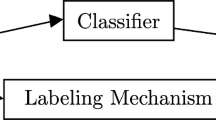Abstract
Probabilistic circuits are deep, tractable generative models capable of computing various types of exact inferences. However, their traditional specifications do not fully account for epistemic uncertainty. To address this, credal probabilistic circuits were introduced, incorporating a way to manage such uncertainty. We propose a novel framework for learning the structure and parameters of credal probabilistic circuits, leveraging the Dempster-Shafer theory of evidence. Unlike previous credal approaches, the framework handles both discrete and continuous data and allows for the use of multiple classification criteria. We conclude by presenting some preliminary experimental results, demonstrating the performance of the proposed models compared to commonly used probabilistic circuits across a range of classification tasks.
Access this chapter
Tax calculation will be finalised at checkout
Purchases are for personal use only
Similar content being viewed by others
Notes
- 1.
The leaf distributions parameterised by \(\varTheta \) may also be relaxed to imprecise models in an analogous manner, but for simplicity we will not consider this here.
- 2.
Essentially, that \(\mathcal {C}\) is ‘separately specified’ using ‘local models’ for each sum node, and that each local model is sufficiently nice, i.e. non-empty, closed, and convex.
- 3.
- 4.
It is worth noting that the criteria from Sect. 3.1 also applies to the general case of multi-class classification.
- 5.
Iterative Row-wise Quadratic Programming Evidential Clustering.
References
Dempster, A.P.: A generalization of Bayesian inference. J. Roy. Stat. Soc. Ser. B (Methodol.) 30(2), 205–247 (1968)
Denœux, T., Sriboonchitta, S., Kanjanatarakul, O.: Evidential clustering of large dissimilarity data. Knowl.-Based Syst. 106, 179–195 (2016)
Gens, R., Domingos, P.: Learning the structure of sum-product networks. In: Dasgupta, S., McAllester, D. (eds.) Proceedings of the 30th International Conference on Machine Learning. Proceedings of Machine Learning Research, vol. 28, pp. 873–880. PMLR, Atlanta (2013)
Levray, A., Belle, V.: Learning credal sum product networks. In: Automated Knowledge Base Construction (2020)
Masson, M.H., Denœux, T.: ECM: an evidential version of the fuzzy C-means algorithm. Pattern Recogn. 41(4), 1384–1397 (2008)
Mauá, D.D., Conaty, D., Cozman, F.G., Poppenhaeger, K., De Campos, C.P.: Robustifying sum-product networks. Int. J. Approximate Reasoning 101, 163–180 (2018)
Montalván Hernández, D.R., Centen, T., Krak, T., Quaeghebeur, E., de Campos, C.: Beyond tree-shaped credal probabilistic circuits. Int. J. Approximate Reasoning 109047 (2023)
Poon, H., Domingos, P.: Sum-product networks: a new deep architecture. In: 2011 IEEE International Conference on Computer Vision Workshops (ICCV Workshops), pp. 689–690 (2011)
Shafer, G.: A Mathematical Theory of Evidence. Princeton University Press, Princeton (1976)
Smets, P.: Decision making in the TBM: the necessity of the pignistic transformation. Int. J. Approximate Reasoning 38(2), 133–147 (2005)
Troffaes, M.C.: Decision making under uncertainty using imprecise probabilities. Int. J. Approximate Reasoning 45(1), 17–29 (2007)
Walley, P.: Statistical Reasoning with Imprecise Probabilities. Chapman and Hall (1991)
Acknowledgements
The authors thank the support from the Eindhoven Artificial Intelligence Systems Institute and the Department of Mathematics and Computer Science of TU Eindhoven. The authors thank Erik Quaeghebeur for their valuable insights and discussions on credal PCs. Cassio de Campos thanks the support of EU European Defence Fund Project KOIOS (EDF-2021-DIGIT-R-FL-KOIOS).
Author information
Authors and Affiliations
Corresponding author
Editor information
Editors and Affiliations
Rights and permissions
Copyright information
© 2024 The Author(s), under exclusive license to Springer Nature Switzerland AG
About this paper
Cite this paper
Montalván Hernández, D.R., Krak, T., de Campos, C. (2024). Dempster-Shafer Credal Probabilistic Circuits. In: Bi, Y., Jousselme, AL., Denoeux, T. (eds) Belief Functions: Theory and Applications. BELIEF 2024. Lecture Notes in Computer Science(), vol 14909. Springer, Cham. https://doi.org/10.1007/978-3-031-67977-3_4
Download citation
DOI: https://doi.org/10.1007/978-3-031-67977-3_4
Published:
Publisher Name: Springer, Cham
Print ISBN: 978-3-031-67976-6
Online ISBN: 978-3-031-67977-3
eBook Packages: Computer ScienceComputer Science (R0)




